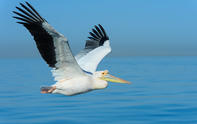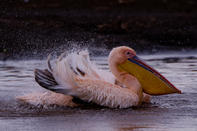Name
Great white pelican - Pelecanus onocrotalus
Also known as an eastern white pelican
Great White Pelican Appearance
The great white pelican is a huge water bird, with short legs and massive long, pink and yellow bill, with a large pale yellow gular pouch. The bill is up to 45 cm in length. An adult will measure up to 170 cm in height and weigh up to 15 kg. The males are larger than females. The great white pelican is usually white in colour, but will take on a pink flush during breeding. In flight, the black primaries and secondary’s contrast with the white coverts on the wings. The eye orbital skin is pink.
Diet
Great white pelicans are surface feeders, which feed on fish. Great white pelicans do not dive under the water to catch their food, but rather use their huge bill to scoop fish on the surface.
These pelicans are opportunistic feeders when breeding. They will eat the eggs and chicks of other birds. This has been recorded on Dassen and Malgas Islands, with Cape gannets being the prey. Pelicans have been known to prey on gannet chicks of up to 2 kgs in size. In Walvis Bay, Namibia, pelicans prey on cormorants. Adult pelicans feed their young chicks, with the chicks that they have caught.
Great White Pelican Breeding
Great white pelicans nest in colonies. They prefer to nest in isolated locations, normally on islands or a remote area, close to water. The nest is a simple pile of twigs on the ground. Two eggs are laid and incubated for around 32 days. The young are cared for by both parents and fledge after 65 to 75 days.
Great White Pelican Behaviour
The great white pelican is gregarious and can be found feeding in large flocks, or singular. By feeding in groups they are able to “herd” the fish into shallower water, to make catching the fish easer. This pelican feeds mostly in the early morning.
The great white pelican is conspicuous in flight as after a few wing beats, it always glides. This pelican needs a long run-up to be able to become airborne. They can often be seen flying in large flocks, in V formations.
For a bird, the great white pelican has a very long life, they have been recorded as reaching 50 years old in the wild.
Threats
None
Great White Pelican Distribution and Habitat
The Great White Pelican is found along the east and west coasts of South Africa, occurring in both freshwater, alkaline and coastal waters.

